One day you’re fine, and the next, you’re struck by excruciating shoulder pain – the kind that takes your breath away. Then comes the first of many sleepless nights. Welcome to the mysterious and miserable world of ‘frozen shoulder’. Clinically termed as ‘adhesive capsulitis’, frozen shoulder can literally develop overnight. The lining (capsule) of the shoulder becomes inflamed and stiff, causing shooting pain with certain arm movements. Eventually, the shoulder ‘freezes’ or could become immobile for a few months, a year or even longer. Frozen shoulder is one of those spontaneous conditions we face as we age. Recovery can be long and grueling if you go it alone, which many people do. Early intervention with an expert physiotherapist gets you back on track faster.
Like many patients, Rustomjee was going to try to ‘tough it out’. After all, who like going to the doctor! But take it from Rustomjee – waiting too long isn’t worth it: “The doctor asked me to perform certain diagnostic movements, like reaching behind my back and up toward my shoulder. These bursts of pain brought tears to my eyes. Within five minutes, he diagnosed me with frozen shoulder. He said it was a good thing I’d come in during the inflammatory phase, before the shoulder froze up. I was relieved when he said I wouldn’t need surgery and, better yet, I could and should keep playing box cricket. Keeping the shoulder mobile would help with recovery, he said. Being sedentary is the worst thing for frozen shoulder. That’s why I hadn’t been sleeping, doctor explained. At night, as you try to rest, the lining of the shoulder tightens up like a T-shirt that’s too small. So, any little motion causes pain and keeps you awake. He recommended an anti-inflammatory injection and regular physiotherapy, which I attended for two months. The physiotherapist used electrical stimulation to loosen up my shoulder and taught me exercises I could do at home to improve my range of motion. If you find yourself trapped in the world of frozen shoulder, don’t wait until you’re desperate, like I did. It started affecting my personal and professional life. Seek help right away, if only to get some peace of mind about what’s wrong. And to finally get a good night’s sleep!”
Rustomjee’s personal medical mystery was solved, but in a larger sense, the condition itself is still a puzzle. While we don’t know exactly why frozen shoulder develops, patients with thyroid problems and uncontrolled diabetes are more prone to it and have a tougher time recovering. Patients who have been in a sling or have been sedentary due to an accident or surgery, also can develop frozen shoulder. Frozen shoulder can affect any adult, but it is most common in women aged 40 to 60. The majority of patients recover without surgery. Recovery can be a long road. Rustomjee was wise to come in during the inflammatory phase. Once a shoulder is frozen, ‘thawing’ it, or rendering it mobile again, takes much longer.
Patients who see a physiotherapist early could recover in a few months, as opposed to longer periods, without intervention. Eventually, frozen shoulder will resolve on its own, but that’s a long time to deal with intermittent pain, mobility issues, and sleep disruption. Most patients recover with nonsurgical therapies. For severely frozen shoulder or patients who are fed up with the pain, surgeons can do arthroscopic surgery. The surgeon looks inside the joint, releases the shoulder capsule, and restores your range of motion. However, you’d still need physical therapy to regain full shoulder mobility.
Here are a few frozen shoulder exercises for you. Always warm up first by taking a warm shower for 10 to 15 minutes or apply a moist heat pack. While performing the following exercises, stretch to the point of tension, but not pain.
 The Pendulum Stretch: Start with this exercise. Relax your shoulders. Stand and lean over slightly, allowing the affected arm to hang down. Swing the arm in a small circle – about a foot in diameter. Perform 10 revolutions in each direction, once a day. As your symptoms improve, increase the diameter of your swing, but never force it. When you’re ready for more, increase the stretch by holding a light weight (three to five pounds) in the swinging arm.
The Pendulum Stretch: Start with this exercise. Relax your shoulders. Stand and lean over slightly, allowing the affected arm to hang down. Swing the arm in a small circle – about a foot in diameter. Perform 10 revolutions in each direction, once a day. As your symptoms improve, increase the diameter of your swing, but never force it. When you’re ready for more, increase the stretch by holding a light weight (three to five pounds) in the swinging arm.
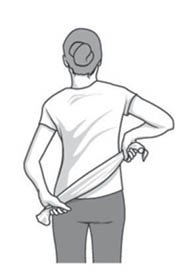 The Towel Stretch: Hold one end of a three-foot-long towel behind your back and grab the opposite end with your other hand. Hold the towel in a horizontal position. Use your good arm to pull the affected arm upward to stretch it. You can do an advanced version of this exercise with the towel draped over your good shoulder. Hold the bottom of the towel with the affected arm and pull it toward the lower back with the other arm. (10 -20 Reps, once daily).
The Towel Stretch: Hold one end of a three-foot-long towel behind your back and grab the opposite end with your other hand. Hold the towel in a horizontal position. Use your good arm to pull the affected arm upward to stretch it. You can do an advanced version of this exercise with the towel draped over your good shoulder. Hold the bottom of the towel with the affected arm and pull it toward the lower back with the other arm. (10 -20 Reps, once daily).
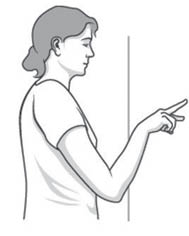
Finger Walk: Face a wall three-quarters of an arm’s length away. Reach out and touch the wall at waist level with the fingertips of the affected arm. With your elbow slightly bent, slowly walk your fingers up the wall, spider-like, until you’ve raised your arm as far as you comfortably can. Your fingers should be doing the work, not your shoulder muscles. Slowly lower the arm (with the help of the good arm, if necessary) and repeat. (10 -20 Reps, daily).
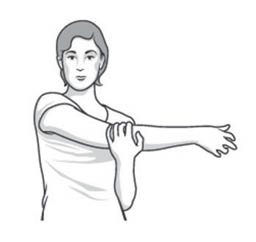
Cross-Body Reach: Sit or stand. Use your good arm to lift your affected arm at the elbow, and bring it up and across your body, exerting gentle pressure to stretch the shoulder. Hold the stretch for 15 to 20 seconds. (10 -20 Reps, daily).
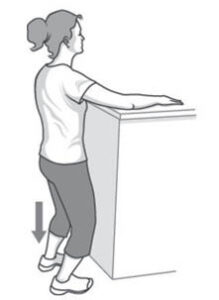
Armpit Stretch: Using your good arm, lift the affected arm onto a shelf about breast-high. Gently bend your knees, opening up the armpit. Deepen your knee bend slightly, gently stretching the armpit, and then straighten. With each knee bend, stretch a little further, but don’t force it. (10 -20 Reps, once daily).
As your range of motion improves, add rotator cuff–strengthening exercises. Be sure to warm up your shoulder and do your stretching exercises before you perform these strengthening exercises.

Outward Rotation: Hold a rubber exercise band between your hands, with elbows at a 90-degree angle close to your sides. Rotate the lower part of the affected arm outward 2 – 3 inches. Hold for five seconds. (10 – 15 Reps, once daily).
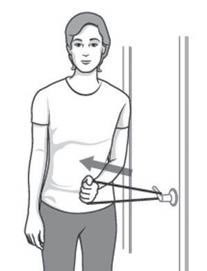
Inward Rotation: Stand by a closed door, hook one end of a rubber exercise band around the doorknob. Hold the other end with the hand of the affected arm, holding your elbow at a 90-degree angle. Pull the band toward your body 2 – 3 inches, and hold for five seconds. (10 – 15 Reps, once daily).
- The Healing Power Of ‘Shinrin-Yoku’ (Forest Bathing) - 28 December2024
- The Incomparable Health Benefits Of Plant-Based Diet - 30 November2024
- The Role Of Physiotherapy In Mental Health: A Holistic Approach - 28 September2024
